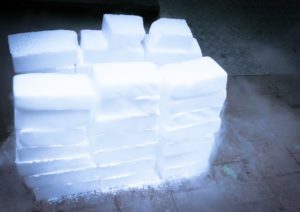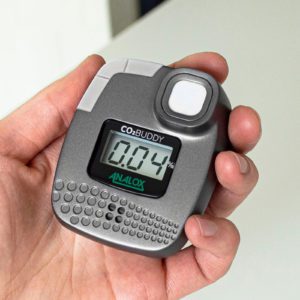How Analox are protecting those who are protecting us.
After the news that vaccine trials have been successful in the fight against COVID-19, the world is now waiting in anticipation for the roll out to begin and for us all to get back to some kind of normality.
One vaccine in particular caught Analox’s eye, the Pfzier & BioNTech vaccine. For this vaccine to remain stable in storage and in transport it needs to be kept at extremely low temperatures. This can be done by using dry ice.

So what is dry ice?
Dry ice is carbon dioxide (CO2) in solid form, it occurs at a temperature of -78.5oC (109.3°F) and is used to keep vaccines, food and other perishable products cold during shipping or storage.
One of the fascinating properties of dry ice is that as it warms, it goes from a solid straight into a gas (CO2), completely skipping the liquid state, a process called sublimation.
If dry ice is stored incorrectly and starts to warm up it will begin to fill the air with Carbon Dioxide, this can be fatal if no alarm is raised.
So while industries are busy preparing for the launch of the vaccine in the hope of saving lives, Analox and our distributors are planning on how to protect those who are protecting us.
"We would welcome anyone with concerns over gas safety to reach out to us"
Becca, Head of Marketing & Communications at Analox
We spoke with Becca, Head of Marketing & Communications to learn how Analox can support the storage and distribution efforts for the vaccine.
How has Analox been affected by the pandemic?
This year has been tough for everyone and Analox is no different, but we have stuck together and we are really proud of what we have achieved. In order to protect our team and continue to support our customers, we initiated a COVID plan which included: A mixture of remote and shift working, we secured our supply chain, and we were listed as a critical business.
Why was Analox listed as a critical business?
Analox provides safety and analysis equipment to the military sector, our systems go on board submarines to protect the lives of submariners across the globe, securing our supply to the Navy is a matter of National Security.
We have also been a key supplier to the lab and medical fields throughout the crisis, predominantly supplying oxygen enrichment monitoring into hospitals.
How can Analox support the vaccine roll out?
We are really looking forward to assisting companies responsible for the storage and distribution of the vaccine. Our carbon dioxide (CO2) monitors offer 3 layers of protection:
- Ensuring the safety of people in areas where the dry ice is stored or used
- Ensures the vaccine arrives at its destination in the optimum condition
- Reduces wastage of dry ice by offering leak alerts
What products do you recommend?
It depends on the application, if you are looking for a portable system, I would recommend our CO2Buddy, this is a lightweight CO2 personal alarm which would be ideal for the likes of the delivery drivers. If you have a storage facility or a distribution centre and you prefer a fixed installation, I would recommend the Ax60+, this is a modular, multi-point system which can monitor CO2 and oxygen (O2) if required and can also link to your BMS (Building Management System).
How can people reach you for advice or to buy a unit?
We would welcome anyone with concerns over safety to reach out to us, we can offer advice, support and more product information if needed. We can be reached by email, phone, website or social media, whatever suits you best.
Dry Ice Safety Solutions
For gas storage areas we offer the Ax60+ fixed gas analyzer which monitors for CO2 and O2 deficiency should you have any inert gases such as liquid nitrogen (LN2) on site.

For personal monitoring we offer the CO2Buddy, this portable alarm is small and robust, making it ideal for delivery drivers.
Dry Ice: The cold hard facts!
Why is dry ice, called dry ice?
Dry ice is carbon dioxide (CO2) in solid form. It is a dense snow like substance that changes directly from a solid to a gas, referred to as sublimation, without going through a liquid stage. Therefore, it gets the name ‘dry ice’.
What is sublimation?
Sublimation is when the change of state of a substance transforms from a solid to gas without first becoming liquid.
How is it made?
Dry ice manufacturing starts with liquid carbon dioxide held under pressure (300 psi) in bulk storage vessels. To begin the process of making dry ice, the liquid CO2 is sent through an expansion valve into an empty chamber where under normal atmospheric pressure it flashes into CO2 gas. This change from liquid to gas causes the temperature to drop quickly. About 46% of the gas will freeze into dry ice snow. The rest of the CO2 gas is released into the atmosphere or recovered to be used again. The dry ice snow is then collected in a chamber where it is compressed into blocks, or various sized pellets.
What about shipping dry ice, is it safe?
During shipping, packages must allow for release of carbon dioxide gas. However, any release of CO2 will create toxic levels of the gas into the environment, a portable CO2 monitor such as the CO2Buddy can keep you safe on the move. Both the Department of Transportation (DOT) and the International Air Transport Association (IATA) regulate shipments of dry ice as it is considered a hazardous material.
Why is it considered hazardous?
Dry ice is considered hazardous for three reasons:
- Explosion hazard: dry ice releases a large volume of carbon dioxide gas as it sublimates. If packaged in a container that does not allow for release of the gas, it may explode, causing personal injury or property damage.
- Suffocation hazard: a large volume of carbon dioxide gas emitted in a confined space may create toxic levels of CO2 in the atmosphere. Dry ice must be stored in a well-ventilated area to minimize the build-up of carbon dioxide.
- Contact hazard: dry ice is a cryogenic material that causes severe frostbite upon contact with skin. Thermal gloves must be used if it is necessary to handle dry ice.
If shipping can be dangerous, what about storing dry ice?
Dry ice must be stored in a well-ventilated location and placed in a container such as a Styrofoam chest, insulated cooler, or a special cooler designed for the storage of dry ice.
Because of the thermal expansion of dry ice (half a kilo of dry ice produces approximately 250 litres of gaseous carbon dioxide), sufficient amount of gaseous carbon dioxide can be released in a sealed container to cause an explosion! Therefore, dry ice must NEVER to be stored in any type of tightly sealed devices such as an ultra-low freezer or plastic/glass container.
Dry ice will sublimate (turn from solid to a gas) about 2.5 to 4.5 kilos every 24 hours (blocks last longer) in a typical storage cooler. Normal air is composed of 78% nitrogen, 21% oxygen, and only 0.04% carbon dioxide. Concentrations of carbon dioxide in the air that is greater than 0.5% (5000 ppm) can become dangerous.

It’s important to take care when using, storing and transporting dry ice, get in touch with Analox today to find out how we can help you and your staff stay safe.


